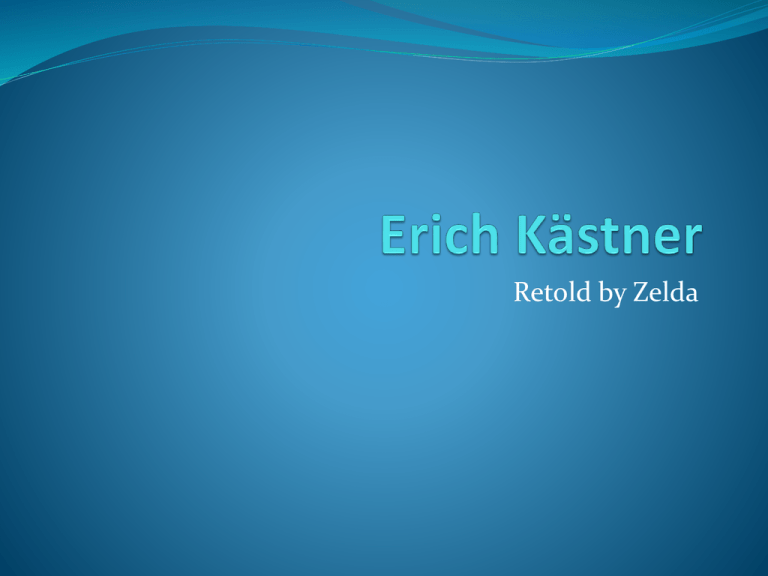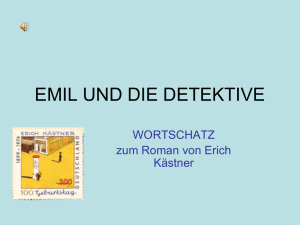Erich Kästner
advertisement

Retold by Zelda *Prologue Erich was born to Emil and Ida Kästner on February 23rd, 1899. Erich’s father, Emil, was a master saddlemaker. His mother, Ida, was a maidservant and housewife, and in her thirties trained to be a hairstylist in order to supplement her husband's income. Erich was the only child born to Emil and Ida. He grew up in the “Königsbrücker Straße“of Dresden's Äußere Neustadt. Chapter 1: “Great Expectations” In 1913, when he was 14, Kästner entered a teacher training school in Dresden, but left the school in 1916 shortly before completing the courses that would have qualified him to teach at public schools. Kästner returned to school at the end of the war and passed his Abitur with distinction, earning a coveted scholarship from the city of Dresden. In the Autumn of 1919, he enrolled in the University of Liepzig to study history, philosophy, theatre, and the German language and literature. His hard work brought him to Rostock and Berlin, and in 1925 he received a doctorate for a thesis on Frederick the Great and German literature. Chapter 2: “The Call of the Wild” In 1914, when he was 15, World War I broke out. He later wrote about the event that it "brought an end to my childhood." Kästner was drafted in 1917 and became part of a heavy artillery company. The brutality of the training he underwent as a soldier affected Kästner profoundly; the merciless drilling by Kästner's sergeant Waurich caused the author a lifelong heart affliction. Kästner critiques the sergeant's character in his poem Sergeant Waurich. This, plus the slaughter of war had a strong influence on his antimilitaris opinions. Chapter 3: “Dr Jekyll and Mr Hyde” Kästner paid for his studies by working as a writer for the prestigious Neue Leipziger Zeitung newspaper. Kästner's increasingly critical reviews and the "frivolous" publication of his sensual poem Abendlied des Kammervirtuosen (Evening Song of the Chamber Virtuoso) got him fired in 1927. The same year, Kästner moved to Berlin. He continued to write for the Neue Leipziger Zeitung under the pseudonym "Berthold Bürger" ("Bert Citizen") as a freelance correspondent. Kästner would later use several other alliases so he could still be published in the same newspaper, such as "Melchior Kurtz," "Peter Flint," and "Robert Neuner". Chapter 4: “Fahrenheit 451” On May 1933, the Nazi supporters burned upwards of 25,000 volumes of "un-German" books. The scripted rituals called for high Nazi officials, professors, rectors, and student leaders to address the participants and spectators. At the meeting places, students threw the pillaged and unwanted books into the bonfires with great joyous ceremony, band-playing, songs, "fire oaths," and incantations. In Berlin, some 40,000 people gathered in the Opernplatz to hear Joseph Goebbels deliver a fiery address: “No to decadence and moral corruption! Yes to decency and morality in family and state! I consign to set flames upon the writings of Heinrich Mann, Ernst Gläser, and Erich Kästner.” “Wo man Bücher verbrennt, verbrennt man am Ende auch Menschen.“ ~Heinrich Heine "Where they burn books, they will in the end also burn people.“ ~Heinrich Heine Chapter 5: “In Cold Blood” Erich had the unique experience of being the only known author to stay behind in Berlin to watch his life’s work be set aflame. It is unsure why Erich stayed behind and didn’t escape Berlin like his fellow authors did during the censorship. Historians believe his bedridden mother might have influenced his choice to stay behind. Kästner had a particularly close relationship with his mother. While he lived in Leipzig and Berlin, he wrote her daily letters and postcards. (His novels, too, seem to be pervaded by overbearing mothers.) Kästner received an exemption to write the well-regarded screenplay Münchhausen under the pseudonym Berthold Bürger in 1942. The Gestapo interrogated Kästner several times, and Kästner was denied entry into the new Nazicontrolled national writers' guild. A “gag order” (black listed) was sent out for Kastner to prevent publishers from printing any more of his work during the Third Reich. He retaliated by going underground and published apolitical novels such as Drei Männer im Schnee (Three Men in the Snow) in Switzerland. Chapter 6: “Brave New World” At the end of World War II, Erich moved to Munich where he published a youth targeted magazine called “Pinguin”. He wrote many skits, songs, audio plays, speeches, essays about post-war Germany during 1945-1951. This span of time was his most productive of all his writing periods. Bombs destroyed Kästner's home in Berlin in 1944. In early 1945, Kästner and others faked a filming assignment in the remote Mayrhofen in Tyrol to avoid the brutal Soviet assault on Berlin. Kästner was in Mayrhofen when the war ended. Kästner wrote about these events an in a diary that was published as Notabene 45 in 1961. Chapter 7: “Paradise Lost” Kästner's optimism during the post-war years soon faded as the people of West Germany attempted to normalize their lives following the economic reforms of the early 1950s and the ensuing boom called the "economic miracle" ("Wirtschaftswunder"). His pacifism suffered further with the call by chancellor Konrad Adenauer and his allies to militarize West Germany. Adenauer wanted to do Germany’s part in defending the democracies of Western Europe and the NATO against the Soviet dictatorships, including communist East Germany. Kästner remained a steadfast pacifist, speaking at the antimilitarist Ostermarsch demonstrations that protested the stationing of nuclear weapons in West Germany. He later also took a stand against the Vietnam War. Kästner began publishing less and less, in part because of growing alcoholism. He did not integrate into any of the post-war literary movements in West Germany and in the 1950s and 1960s was remembered as mainly an author of children's books. Kästner was not rediscovered as the serious writer of his work during the Weimar Republic until the 1970s. Chapter 8: “A Tale Of Two Cities” In his Notebene 45 entry in 1945, Kästner describes his shock at arriving in Dresden shortly after its firebombing in February 1945 and finding it a pile of ruins. So much so that he could recognize none of the streets and landmarks among which he had spent his childhood and youth. His autobiographical book When I Was a Little Boy begins with a lament for Dresden: "I was born in the most beautiful city in the world. Even if your father was the richest man in the world, he could not take you to see it, because it does not exist any more. In a thousand years was her beauty built, in one night was it utterly destroyed". Chapter 9: “Gone With The Wind” He passed away on July 29th, 1974. He was 75 years old. Hans Sarkowicz and Franz Josef Görtz list over 350 stories that Erich’s written from 1923 to 1933, but the actual number may be much higher. Much was lost when Kästner's flat burnt during a WWII bombing raid in February, 1944. After his death, the Bavarian Academy of Arts established a literary prize in his memory: The Erich Kästner Prize. Das Doppelte Lottchen (The Double Lottie) *Released in 1949 Two nine-year-old girls (feisty Lisa Palfy from Vienna, and shy Lottie Horn from Munich) meet on a summer camp in Bohrlaken on Lake Bohren. They have never seen each other before, but soon find out that they are identical twins. They switch places to fool their parents. Der 35. Mai (The 35th of May) Published in 1932 With the help of a talking horse named Negro Caballo, Conrad and his Uncle enter into a huge wardrobe, and end up in a series of fantasy lands, starting with the land of Cockaigne ("free entry — children half price"), followed by a mediaeval castle complete with jousting, an upside-down world in which children send bad parents to reform school, and a science fiction nightmare city with mobile phones. They can only get to this world on the 35th of May, one shot deal. Emil und Die Detektive Published in 1929 Emil and the Detectives was Erich’s biggest success, was translated into over 58 languages, and was one of his few books to escape Nazi-censorship (it was considered too popular and too harmless, thus escaping the ban.) It has had multiple plays, movies, and tv shows made from the book. Gerhard Lamprecht's 1931 film version of Emil und die Detektive was a great success. Kästner, however, was dissatisfied with the screenplay. This led him to work as a screenwriter for the Babelsberg film studios. The Emil books had an important role in popularizing the sub-genre of "Children Detectives", later taken up by other writers of children's books such as Enid Blyton. *Discussion Guide Online sources: http://www.theweeweb.co.uk/public/author_profile.php?id=388 http://kirjasto.sci.fi/kastner.htm http://www.historyplace.com/specials/faq/index.html http://en.wikipedia.org/wiki/The_35th_of_May,_or_Conrad%27s_ Ride_to_the_South_Seas http://www.ushmm.org/wlc/en/article.php?ModuleId=10005852 Book sources: Display: 5 German Authors, Their Life & Work Publication by: Inter Nationes Bad Godesberg







